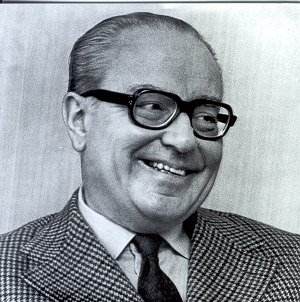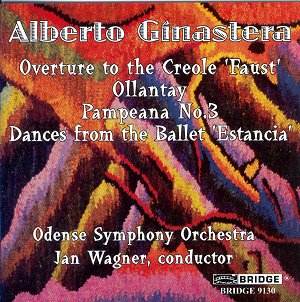
Although there are some important works still
awaiting recording (e.g. the large-scale choral-orchestral Turbae
ad Passionem Gregorianam Op.43, various orchestral works
and the operas), Ginastera’s music has so far been reasonably
well served on record.
Ginastera’s early works were directly inspired
by and influenced by Argentine folk music. This is evident in
the early pieces recorded here. Estancia Op.8 is
Ginastera’s second ballet score and the suite of dances drawn
from it is fairly well known and popular. Many will remember Goossens’
recording release during the LP era. It thus does not call for
many comments. This colourful and rhythmically energetic score
is a sort of Argentine Rodeo (Ginastera studied
with Copland) of which the concluding Malambo is particularly
popular. The Obertura para el ‘Fausto’ Criollo Op.9
is inspired by a poem of the 19th century writer Estanislao
del Campo which tells of a gaucho travelling to Buenos Aires and
attending a performance of Gounod’s opera Faust.
On his way back, he meets an old friend and tells him in his own
words about his operatic experience while sharing a bottle of
gin. Thus, the overture aptly and humorously mixes reminiscences
of Gounod’s score with Argentine rhythms. A short delightful work
and a good example of Ginastera in outdoor mood. It has also been
recorded earlier and many will remember Howard Hanson’s recording
released many years ago on Mercury - it was re-issued in CD format
some years ago. More recently, it has been available in a collection
of short Latin American works (Caramelos Latinos ["Latin
American Lollipops"]) on Dorian DOR 90227.
Ginastera recognised three periods in his creative
output: one of "subjective nationalism" (that of, say,
Panambi and Estancia), one of "objective
nationalism" in which folk elements are transcended in much
the same way as Bartók did in his mature works. The last
which he described as "Neo-Expressionism" relates to
the three operas and the important later works (e.g. the piano
concertos, the cello concertos, the string quartets). The three
symphonic movements Ollantay Op.17 belong to the
second phase. Folk elements are obviously present but no longer
dominate. They are much more integrated into the symphonic argument.
Though inspired by a poem from the early Inca period, it is on
the whole more abstract and eschews any picturesque superficiality.
This substantial orchestral triptych opens with a contemplative,
impressionistic first panel followed by a powerful Scherzo (The
Warriors) and ends with another beautiful slow movement (The
Death of Ollantay). Malcolm MacDonald is right when he writes
that Ollantay is the nearest approach to the symphony
on Ginastera’s part. He is however partly wrong when he mentions
that Ginastera never wrote a symphony. He actually wrote two of
them: the First Porteña in 1942 and the Second Elegiaca
in 1944 though – significantly enough – they were given no opus
number and were withdrawn some time later. Ollantay Op.17
was commissioned by the Louisville Orchestra who premiered it
in 1954 and recorded it on LP (Louisville S-696). Another recording,
in CD format, is available on Largo 5122 (live recording). Though
the present performance is undoubtedly much better in many respects,
the Largo disc may be well worth finding for a complete Panambi.
Ginastera composed three works sharing the title
of Pampeana - a word alluding to the rhythms and melodies
of the Argentine pampas. Pampeana No.1 Op.16 for
violin and piano and Pampeana No.2 Op.21 for cello
and piano are short rhapsodic pieces. The Pampeana No.3
Op.24 is an altogether more ambitious and substantial
orchestral triptych in the same vein as Ollantay.
It too has a central rhythmic Scherzo framed by two slow, expressive
movements. Again, in spite of its title and subtitle (‘Symphonic
Pastoral in three movements’), this is another purely abstract
and tightly argued piece of music. The present performance is
very fine indeed and favourably compares with the late Eduardo
Mata’s reading available on Dorian DOR 90178.
As I mentioned when beginning this review, Ginastera’s
music is fairly well represented in the catalogue, though some
recordings may have passed unnoticed. His present discography
includes several outstanding releases (Naxos 8.555283
[Piano Concertos], ASV CD DCA 944 [String Quartets] and Newport
Classics NPD 85580 [Cello Concertos]). The present release may
safely be added to that list. I hope that we may get more Ginastera
from the present forces. Warmly recommended.
Hubert Culot
